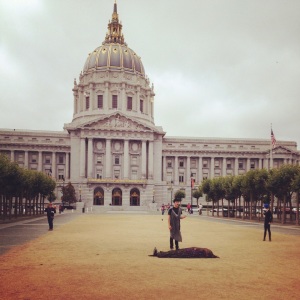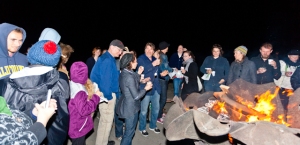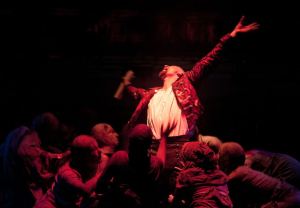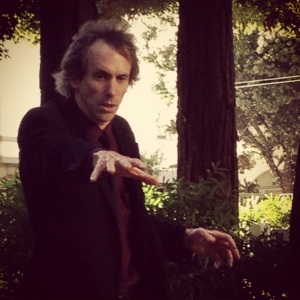In 2012, to commemorate SF Shakes’ 30th anniversary of performing Free Shakespeare in the Park in San Francisco, we devised a unique celebration – 30 separate performances of scenes from 30 of Shakespeare’s plays in small parks all over San Francisco– primarily “parklets,” green spaces devised from parking spaces in front of cafes and restaurants. The performances were designed to “pop up” – that is, they were announced only on Facebook and Twitter, and most of the people who encountered them weren’t aware they were about to happen. Suddenly, during the lunch hour, the afternoon commute, or weekend brunch hours, our performers would begin a scene from Shakespeare – about ten minutes long and designed to be self-contained, so that passers-by unfamiliar with the play could still understand what was going on.
At the end of each performance, we announced what had just happened and passed out flyers for Free Shakespeare in the Park. Then we dashed back to the office to post photos on Facebook – not only did we have fans seeing the performances live, we also had a virtual audience following the shows only through the on-line photographs.
Gabriel McCulloch in Julius Caesar at City Hall.
From the end of July through the end of August, we performed almost daily, using about 75 performers of all ages and backgrounds, including Shakespeare campers, interns, and union professionals. We capped it all off on the 30th day with a community reading of “O for a Muse of Fire” around a bonfire on Ocean Beach, to which all were invited – performers, fans, audience, and a few refugees from another bonfire who happened upon our group.
Henry V Bonfire at Ocean Beach.
Speaking as the one person who attended every performance and directed a majority of them, it was glorious, it was thrilling, it was a little bit dangerous – everything live theatre should be. It was also exhausting. When asked whether Free Shakespeare in the Parklet will be back again this year, I’ve said yes – but not 30 of them!
How could we not repeat such an exciting and successful experience? And, while repeating it, how could we not attempt to build and improve upon what we’ve done before?
Jason Kapoor in The Taming of the Shrew at Mission Playground.
This year, we are in the process of planning a total of 15 performances of 9 scenes, plus a communal reading. Three scenes will appear only in San Francisco. Three scenes will appear in both SF and Cupertino. Three scenes will appear in both SF and Redwood City. “Thrice to thine and thrice to mine/And thrice again to make up nine,” as the Wayward Sisters chant in Macbeth. The scenes will revolve around the theme of “Sorcery and Skullduggery” in order to further explore the themes of witchcraft and crime in Macbeth. We will include two of the plays we didn’t get to perform last year – Titus Andronicus and Henry VI Part 1 – and also explore three plays by Shakespeare’s contemporaries, Doctor Faustus by Christopher Marlowe, The Duchess of Malfi by John Webster, and The Witch by Thomas Middleton.
Stephen Pawley* in Cymbeline at Cafe Seventy8.
The plays will be presented in roughly chronological order of the time of writing, beginning with Marlowe’s game-changing Doctor Faustus. Christopher Marlowe is an endlessly intriguing character, a sort of cross between Stephen Spielberg and James Bond. Unlike Shakespeare, he was a University man, a graduate of Cambridge. He went from there to London, where from 1587 to 1593, he turned out an incredible string of successful shows before he was killed at age twenty-nine, including The Jew of Malta, Edward II, Tamburlaine Parts 1 and 2, and Doctor Faustus.
Christopher Marlowe and his fabulous hair.
Not content merely to transform English playwriting, he seems to have also been a secret agent for the Crown, quite possibly spying on English Catholics abroad. While on the one hand he worked for the Queen, on the other he ran into trouble with the Privy Council for “seditious behavior” including atheism. Shortly after he received a visit from Sir Thomas Walsingham about these charges, he was “accidentally” killed in a tavern brawl. Historians have wondered ever since if this wasn’t a little too much of a coincidence.
Arguably, without Marlowe, there would have been no Shakespeare. My favorite kooky authorship theory asserts that in fact, they were the same person – Marlowe wasn’t murdered, but lived, only to disguise himself as the other playwright for the rest of his life.
Marlowe took the new iambic pentameter verse style that poets such as Sir Philip Sidney had explored in sonnets, and gave it to actors to speak on the stage. As it turned out, iambic pentameter suited the stage very well. In Marlowe’s hands, it had a muscular drive and structure that sounded as natural as a heartbeat. As Bernard Beckerman notes in his introduction to “Five Plays of the English Renaissance”:
Marlowe brought a stunning theatricality to the public playhouse. It was a theatricality that infused both language and action. In the few years leading to the appearance of Tamburlaine, English dramatic style became set, and Marlowe did much to set it. For more than thirty years before him, English playwrights and poets had experimented with stage speech… sometime in the mid-1580s Marlowe, and Thomas Kyd along with him, vitalized blank verse and stormed the stage with it. Whichever of these two men first showed the way, it was Marlowe with his mighty line who hypnotized the London audience.
Doctor Faustus at the Royal Exchange, Manchester.
Of the top four hits of the London stage between 1588 and 1593, two were by Marlowe – Faustus and the number one hit The Jew of Malta. With these plays and others, Marlowe not only transformed the language of playwriting, he also brought to the stage the Renaissance incarnation of the tragic hero, a man caught between the sacred and the secular. As Faustus sells his soul to the devil, we can see the temptation – he has mastered the other arts and sciences, why not the occult as well? Marlowe makes Faustus’ thirst for knowledge appealing and understandable – as Beckerman says, “That he succumbs to powers greater than his own does not demean his attempt.”
The connections to Macbeth, written a decade and a half later, are clear – not only in the two plays’ shared concern with the occult, but in their ambitious heroes. As with the witches in Macbeth, it’s easy to imagine Elizabethan audiences fearing that Faustus was really calling on dark powers. Even now, his spells send chills down the spine. As he gleefully enjoys the spoils of his new-found power, we feel, as we do with Macbeth, that his comeuppance will be as terrible as his power is glorious.
Phil Lowery in Macbeth at the Transamerica Redwood Park.
We will present a cutting of the first two scenes of Doctor Faustus this Saturday, July 13, at 12:30 pm in front of the Cupertino Library, and about a week later at an SF location to be announced, featuring Galen Murphy-Hoffman*, Leighland Hooks, Madeline Knutson, and Emily Nappi. (*Member, Actors’ Equity Association)
Our second scene is from Shakespeare’s early history play The Tragedy of Richard III. Taken from Act I, scene 4, it is an exquisite little one-act all by itself. In it, Richard’s brother George, Duke of Clarence, has been imprisoned in the Tower – he thinks by their oldest brother King Edward, but it’s really due to Richard’s machinations. Clarence pours his heart out to the Master of the Tower, Brakenbury – he’s had a terrible nightmare and cannot sleep, he’s so guilt-ridden over the deaths of the people he killed to get Edward to the throne. It’s all very ominous – it reminds one of Macbeth’s “Sleep no more”– and sure enough, as soon as Clarence is asleep, two murderers appear. And here the play turns deftly from poetic lyricism to comic repartee. One murderer is reluctant, so the other must convince him. Just as Clarence has reflected on mortality, so do the two clowns, until Clarence wakes up and the deed must be done.
Richard III was written in approximately 1592, as a sequel of sorts to the Henry VI trilogy of blockbusters. (We in the 21st century like our superhero movies – for the Elizabethans, the Tudors and Plantagenets were the big box office draw.) Although Richard III is often compared unfavorably to the great tragedies that followed, it is full of delicious scenes and memorable characters.
Ryan Tasker* and Alexandra Creighton in Richard III at Pizzeria Delfina.
Richard III will be performed at the Oaks Shopping Center in Cupertino, by the big oak in front of Dance Academy USA, at 11:00 am on Sunday, July 14, and on Saturday, July 20 in San Francisco, location TBA. It will feature Ryan Tasker*, Radhika Rao, Tristan Cunningham*, and Brian Herndon*. (*Member, Actors’ Equity Association)
Watch this blog, follow us on Facebook or @sfshakes on Twitter for more information about upcoming Free Shakespeare in the Parklet scenes popping up near you – we hope to see you there!












It’s difficult to find experienced people for this subject, but you seem
like you know what you’re talking about! Thanks